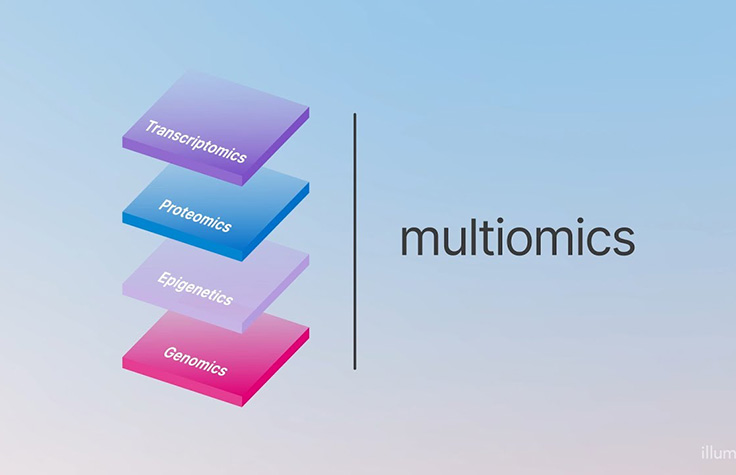CITE-Seq

What is CITE-Seq?
CITE-Seq (cellular indexing of transcriptomes and epitopes) is a sequencing-based method that simultaneously quantifies cell surface protein and transcriptomic data within a single cell readout. Studying cells concurrently at transcriptomic and proteomic levels can offer unprecedented insights into new cell types, disease states, or other conditions.

Why is CITE-Seq Useful?
Before the development of CITE-Seq, studying the transcriptome and protein expression simultaneously was challenging to achieve at the single-cell level. Using transcriptional information to understand cell physiology is helpful, but it doesn't provide the entire picture as cell function is incomplete without protein expression information. RNA analysis cannot accurately measure post-transcriptional and translational modifications such as protein degradation, isoform detection, and glycosylation. A long-standing method to study surface protein expression, such as flow cytometry, is robust but has been traditionally limited by the number of targets that can be analyzed, plus it cannot simultaneously provide transcriptomic data. CITE-seq accomplishes both of these goals in a single assay to provide a comprehensive view of single-cell function.

What are the Advantages of Using CITE-Seq?
CITE-Seq solves the problem of detecting a limited number of proteins while using single-cell sequencing to study transcripts in an unbiased way. Wielding the technology of barcoded antibodies, CITE-Seq is capable of analyzing a near-limitless number of cell markers along with transcripts in a single run. Combined with existing single-cell sequencing methods, our sequencing platforms ensure a smooth workflow to identify novel advancements with high throughput, scalability, and speed.
How Does CITE-Seq Work?
CITE-seq uses unique oligo-tagged antibodies to identify surface proteins, using sequencing as a readout. The number of barcodes that can be conjugated to antibodies surpasses the number of fluorophores or heavy metal tags used in flow cytometry or CyTOF, expanding the number of proteins that can be measured simultaneously with RNA. These barcoded antibodies are part of a unique workflow that produces protein and nucleic acid data using next-generation sequencing (NGS) technologies.
Make Deeper Discoveries Using CITE-Seq
Explore solutions to simultaneously profile surface proteins and mRNA in single cells.
Download ArticleRecent Insights from CITE-Seq
CITE-Seq has enabled important discoveries by using multiplexed quantification of proteins and transcriptomic data all within single cells. Here are just a few examples of CITE-Seq's capabilities:
- By profiling immune cells, researchers from the University of Minnesota can now see that a heterogeneous population of macrophages can prevent heart damage.1
- Using CITE-Seq, breast cancer cells can be categorized based on their cellular makeup and how they respond to treatments. This innovative development now provides a “comprehensive transcriptional atlas” of cells to help unravel the complex heterogeneity of breast cancer cells.2
- See how CITE-Seq improved the understanding of mild to moderate disease in COVID-19 patients through the analysis of immune cells.3
Get a Broader Understanding of Breast Cancer Cells
See how scientists are using our NGS-based systems to understand phenotypic and transcriptomic information at the single-cell level.
Learn MoreExpand and Empower Your Research with Multiomics
Get a holistic perspective by combining genomics with transcriptomics, epigenetics, and proteomics.
Download eBook
CITE-Seq vs. REAP-Seq
RNA expression and protein sequencing (REAP-seq) and CITE-seq are based on similar principles. With the development of commercial reagents to support both protocols, many researchers now refer to them interchangeably or use the terms proteogenomics or multiomic analysis.
Compatible Solutions
AbSeq from BD
BD AbSeq Antibody-Oligonucleotide Conjugates allow for the detection of proteins and mRNA expression in a single experiment. These reagents are designed to work seamlessly with the BD Rhapsody Single-Cell Analysis system.
TotalSeq from BioLegend
BioLegend offers multiple formats of antibodies for the simultaneous detection of protein and RNA or DNA by sequencing using their TotalSeq oligo-conjugated antibodies for single-cell analysis.
10x Genomics Feature Barcode technology
10x Genomics offers a wide range of solutions for the co-detection of protein and gene expression in single cells.
Featured Multiomics Applications
Simultaneously profile hundreds of cell markers
Read how researchers mapped 197 surface markers to cellular profiles using BD Rhapsody and Illumina NGS systems at single-cell resolution in a single experiment.
Unique Molecular Signature Detection in Th1-polarized Cells
Optimize BEN-Seq using Illumina NGS and BioLegend TotalSeq Antibodies for bulk protein and gene expression profiling in Th1 cells.
TotalSeq-A for Proteomic Analysis and RNA-Seq Experiments
Learn how to optimize TotalSeq-A (BioLegend) antibodies along with RNASeq to add a cost-effective proteomic analysis into your workflow.
Multiomic Analysis at Single-Cell Resolution
Simultaneously profile gene and protein expression for B-cells and T-cells at single-cell resolution using 10x Genomics Chromium Single Cell Immune Profiling and Illumina sequencing systems.
CITE-Seq Data Analysis
Widely available user-friendly tools provide a simple yet powerful way for you to analyze data without a bioinformatics background. 10x Genomics, BD, and Biolegend offer robust analytics pipelines and visualization tools to aid the interpretation of CITE-Seq data. Alternatively, you can conveniently normalize and integrate gene and protein expression data from CITE-Seq experiments using free open source software such as Seurat or CiteFuse.
Study Gene Expression and Regulation using NGS
Learn how gene expression and protein production are controlled in different types of cells.
Download eBookProtein and Transcript Data in a Single Workflow
The NextSeq 2000 and NovaSeq 6000 systems support high-throughput sequencing capacity to power CITE-Seq assays. Oligo-conjugated antibodies combined with single-cell library preparation solutions use barcodes to link proteome and transcriptome profiles to single cells. Sophisticated software analysis platforms can decode protein and gene expression data to help you identify unique cell phenotypes.
Sample and Library Preparation
Combine gene and protein expression assays into a single workflow.
Sequencing
Quantify data using a single sequencing run.
Data Analysis
Discover insights using powerful analysis and visualization software platforms.
Single-Cell Sequencing Sample Prep Tips
Overcoming Challenges of Single-Cell Research
Experts from S2 Genomics, Dolomite Bio, and Illumina will provide key insights and tips to optimize your single-cell research for scRNA-seq, SNuc-seq, ATAC-seq, and more.
Best Practices for Single-Cell Sequencing
Whether you are new or experienced in single cell sequencing techniques, this webinar will provide you with the best up-to-date practices for sample preparation and quality control for your workflow.
Single-Cell Workflow eBook
Learn valuable tips on single-cell sequencing to gain higher discovery power for your research.
Related Content
Multiomics
Want to learn about how you can integrate multiple levels of data into your research? Find out how multiomics can provide you a more comprehensive understanding of biological systems.
Cell & Molecular Biology
We offer technologies to go beyond traditional cell and molecular biology research techniques so you can harness the power of genomic, transcriptomic, and epigenomic data efficiently and accurately.
Single-Cell RNA Sequencing
Single-cell RNA sequencing can provide solutions to unravel complex biological systems at high resolution with minimal sample input.
CRISPR Genome Editing
CRISPR has revolutionized genetic research by enabling precise genomic editing. Learn how NGS-based approaches can be used to confirm CRISPR-based edits and analyze off-target effects.
References
- Circ Res. 2021 Oct 14. doi: 10.1161/CIRCRESAHA.121.319737 “Cardiac Resident Macrophages Prevent Fibrosis and Stimulate Angiogenesis”
- Nat Genet. 2021 Sep;53(9):1334-1347. doi: 10.1038/s41588-021-00911-1. “A single-cell and spatially resolved atlas of human breast cancers”
- Cell. 2020 Dec 10;183(6):1479-1495.e20. doi: 10.1016/j.cell.2020.10.037. “Multi-Omics Resolves a Sharp Disease-State Shift between Mild and Moderate COVID-19“